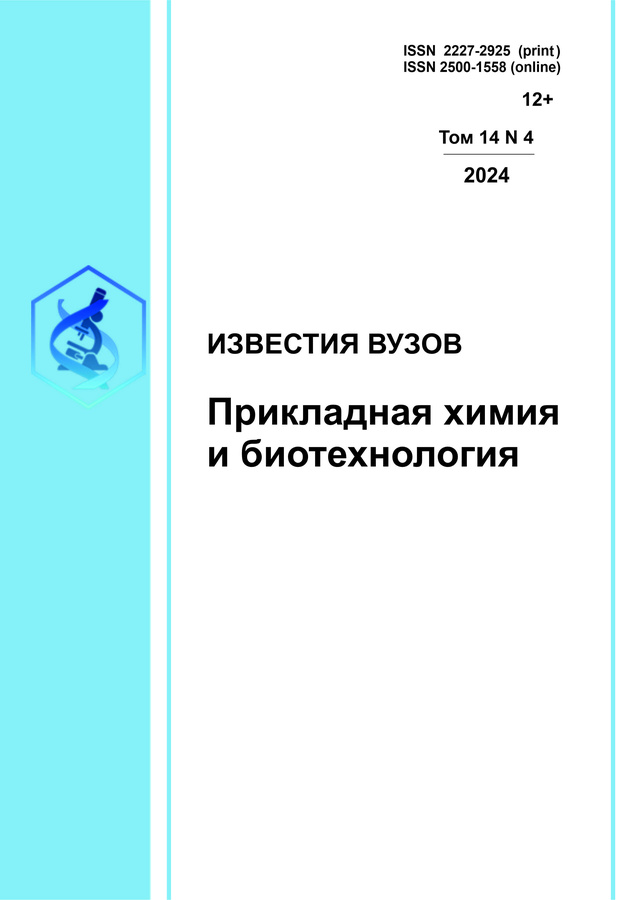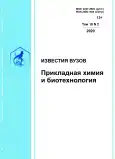Образование гуминоподобных веществ в реакции D-глюкозы с п-толуидином в безводном этаноле
- Авторы: Черепанов И.С.1, Крюкова П.С.1
-
Учреждения:
- Удмуртский государственный университет
- Выпуск: Том 10, № 2 (2020)
- Страницы: 188-195
- Раздел: Химические науки
- URL: https://bakhtiniada.ru/2227-2925/article/view/299673
- DOI: https://doi.org/10.21285/2227-2925-2020-10-2-188-195
- ID: 299673
Цитировать
Полный текст
Аннотация
Целью исследования являлось изучение процессов образования и структурно-группового состава продуктов взаимодействия D-глюкозы с п-толуидином в среде безводного этанола методами электронной и колебательной спектроскопии. Эволюция профилей электронных спектров рабочих растворов показывает формирование хромофорной системы: четкие пики при 380 и 440 нм регистрируются уже при продолжительности реакции 60 мин. Появление дополнительного максимума при 520 нм (90, 120 мин), вероятно, отвечает образованию хромофоров конденсированных структур, что подтверждается уменьшением значений индексов Е4/Е6 со временем. Динамика трансформации структурных элементов также отчетливо прослеживается при анализе ИК-спектров: по мере протекания реакций СН-алифатическая составляющая структуры уменьшается, при этом увеличивается ароматизация и функционализация продуктов хромофорными группами. Для продуктов, полученных в течение 90 и 120 мин термостатирования, в спектрах фиксируется четкая полоса при 1656 см-1, относимая к валентным колебаниям кратных связей в сопряженных системах С=С‒С=О и азометиновых фрагментах, что указывает на протекание реакций конденсации. В спектрах фракционированных водой нерастворимых твердых продуктов интенсивность полос при 1656 и 1190 см-1 существенно снижается, возможно, за счет перехода части окрашенных низкомолекулярных продуктов в водную фазу. Сопоставление характера ИК-Фурье-спектров конечных твердых продуктов со спектрами природных и синтетических гуминоподобных веществ показывает их сходный структурно-групповой состав. Интенсивность полос при 1620, 1508 и 815 см-1 свидетельствует о существенном вкладе ароматической составляющей в структуру продуктов водонерастворимых фракций, при этом в состав водорастворимых фракций входят в основном алифатические кислородсодержащие структуры, образующиеся в результате окислительной деструкции исходного углевода. Синтезированные продукты представляются перспективными в качестве доступных регуляторов роста растений с контролируемым выделением активного вещества.
Ключевые слова
Об авторах
И. С. Черепанов
Удмуртский государственный университет
Автор, ответственный за переписку.
Email: cherchem@mail.ru
П. С. Крюкова
Удмуртский государственный университет
Email: cherchem@mail.ru
Список литературы
- Goh K.M., Stevenson F.J. Comparison of infrared spectra of synthetic and natural humic and fulvic acids // Soil Scince. 1971. Vol. 112. Issue 6. P. 392–400.
- Stevenson F.J., Goh K.M. Infrared spectra of humic acids and related substances // Geochimica et Cosmochimica Acta. 1971. Vol. 35. Issue 5. P. 471–483. https://doi.org/10.1016/0016-7037(71)90044-5
- Sumerskii I.V., Krutov S.M., Zarubin M.Ya. Human-like substances formed under conditions of industrial hydrolysis of wood // Russian Journal of Applied Chemistry. 2010. Vol. 83. Issue 2. P. 320–327. https://doi.org/10.1134/S1070427210020266
- Litvin V.A., Galagan R.L., Minaev B.F. Synthesis and properties of synthetic analogs of natural humic acids // Russian Journal of Applied Chemistry. 2012. Vol. 85. Issue 2. P. 296–302. https://doi.org/10.1134/S1070427212020243
- Koroleva O.V., Kulikova N.A., Alekseeva T.N., Stepanova E.V., Davidchik V.N., Belyatva E.Yu., et al. A comparative characterization of fungal melanin and humic-like substances synthesized by Cerrena maxima 0275 // Applied Biochemistry and Microbiology. 2007. Vol. 43. Issue 1. P. 61–67.
- Liang L., Zhou M., Li K., Jiang L. Facile and fast polyaniline-directed synthesis of monolithic carbon cryogels from glucose // Microporous and Mesoporous Materials. 2018. Vol. 265. Issue 1. P. 26–34. https://doi.org/10.1016/J.micromeso.2013.01.035
- Bai C., Shen F., Qi X.-H. Preparation of porous carbon directly from hydrothermal carbonization of fructose and phloroglucinol for adsorption of tetracycline // Chinese Chemical Letters. 2017. Vol. 28. Issue 5. P. 960–962. https://doi.org/10.1016/j.cclet.2016.12.026
- Shul’tsev A.L. N-glycosides of 4-aminostyrene // Russian Journal of General Chemistry. 2014. Vol. 84. N 2. P. 235–241. https://doi.org/10.1134/S1070363214020133
- Черепанов И.С. Оценка параметров ароматичности продуктов карбонизации в системах углевод–ариламин // Известия высших учебных заведений. Северо-Кавказский регион. Технические науки. 2018. N 4 (200). С. 118–123. https://doi.org/10.17213/0321-2653-2018-4-118-123
- Gressel N., McGrath A.E., McColl J.G., Powers R.F. Spectroscopy of aqueous extracts of forest litter. I. Suitability of methods // Soil Science Society of Arnerica Journal. 1995. Vol. 59. Issue 6. P. 1715–1723. https://doi.org/10.2136/sssaj1995.03615995005900060030x
- Van Zandvoort I., Koers E., Wiengarth M., Bruijnincx P., Baldus M., Weckhuysen B. Structural characterization of 13C-enriched humins and alkali–treated 13C-humins by 2D solid–state NMR // Green Chemistry. 2015. Vol. 17. Issue 8. P. 4383–4392. https://doi.org/10.1039/C5GC00327J
- Жеребцов С.И., Малышенко Н.В., Вотолин К.С., Андроханов В.А., Соколов Д.А., Дугаржав Ж.. Гуминовые препараты: связь структурно-группового состава и биологической активности // Вестник Кузбасского государственного технического университета. 2018. N 5 (129). С. 52–60. https://doi.org/10.26730/1999-4125-2018-5-52-60
- Tsilomelekis G., Orella M., Lin Z., Cheng Z., Zheng W., Nikolakis V., et al. Molecular structure, morphology and growth mechanism and rates of 5-hydroxymethylfurfural (HMF) derived humins // Green Chemistry. 2016. Vol. 18.Issue 7. P. 1983–1993. https://doi.org/10.1039/c5gc01938a
- Yaylayan V., Kaminsky E. Isolation and structural analysis of Maillad polymers: caramel and melanoidin formation in glycine/glucose model system // Food Chemistry. 1998. Vol. 63. Issue 1. P. 25–31.
- Yang Y.-H., Sheng F.-L., Tao Z.-Y. Transmission FT-IR difference spectroscopic characterization of a fulvic acid from weathered coal in water // Toxicological and Environmental Chemistry. 1995. Vol. 51. Issue 1-4. P. 135–144. https://doi.org/10.1080/02772249509358231
- Jung A.-V., Frochot C., Parant S., Lartiges B.S., Selve C., Viriot M.-L., et al. Synthesis of amino-phenolic humic-like substances and comparison with natural aquatic humic acids: a multi-analytical techniques approach // Organic Geochemistry. 2005. Vol. 36. Issue 9. P. 1252–1271. https://doi.org/10.1016/j.orggeochem.2005.04.004
- Patil S.K.R., Lund C.R.F. Formation and growth of humins via aldol addition and condensation during acid-catalyzed conversion of 5-hydroxymethylfurfural // Energy and Fuels. 2011. Vol. 25. Issue 10. P. 4745–4755. https://doi.org/10.1021/ef2010157
- Пат. № 2101227, Российская Федерация. Ароматические основания Шиффа в качестве регулятора роста растений / В.П. Тимофеев, Ф.А. Селимов, У.М. Джемилев; патентообладатель Стерлитамакский нефтехимический завод; заявл. 04.08.1995, опубл. 10.01.1998.
- Palande S.V., Swamy D.K. Synthesis, characterization and biological activity of Schiff base 2{-methyl}-phenol and its transition metal complexes // International Research Journal of Science and Engineering. 2018. Special Issue A2. P. 35–40.
- Атабаева А.М., Джеджея В.Т., Лусс А.Л., Устинова М.С., Штильман М.И. Полимерные формы регуляторов роста растений // Успехи в химии и химической технологии. 2019. Т. 33. N 2. С. 18–19.
Дополнительные файлы










